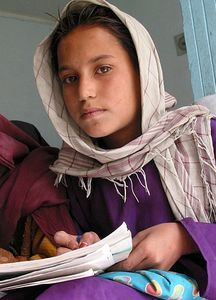Changes Suggested to Stem Afghan Child Marriage
Reducing the number of Afghan child brides will require policy changes, legal initiatives and a far-reaching public awareness campaign, according to a research team led by a BU School of Public Health professor.

Although the overthrow of Taliban rule in Afghanistan in 2002 led to a number of human rights reforms, at least half of Afghan girls still marry before the legal age of 16, and many are forced into marriage, a recent United Nations report shows. In a paper published in the journal Violence Against Women, Anita Raj, professor of community health sciences, and colleagues found that Afghani police, teachers, government workers and religious leaders were well-aware of the negative impacts of child marriage, including increased risks of maternal and child mortality. But the researchers found that conflicting civil and religious laws, inadequate policy enforcement and a lack of support for girls and women are fueling the continuing trend in underage marriages.
The group recommended a four-pronged approach to stemming such marriages: Conduct a public education campaign to clarify a conflict between civil law and Sharia law, which sanctions marriage after puberty; require legal marriage registration, to ensure that brides and grooms are of legal age; develop programs to support young girls who are already married; and, on a larger scale, improve educational and job opportunities for women.
“Overall, findings document a number of prevention opportunities that should be considered to help alleviate the pervasiveness of child and forced marriage of girls in Afghanistan,” Raj and her co-authors wrote. “Given the substantial changes for the better made since 2001. . . it is not unrealistic to remain optimistic about the status of women and girls in Afghanistan.”
The study was based on more than 100 interviews conducted by Medica Mondiale, an international organization dedicated to supporting women and girls in troubled regions. The interviews revealed a widespread awareness that civil law sets the legal age of marriage at 16, and that early marriage poses risks to women’s and babies’ health, as well as negative social consequences, such as stymieing the young mother’s education.
Of concern to the research team was a belief expressed by some participants that early marriage could be “protective and beneficial for girls, and that such benefits outweigh the understood risks.” Such beliefs were more often noted by religious leaders than by other interest groups, the authors said.
They noted that “conflicting civil and religious laws – both are recognized by the government of Afghanistan – may be inhibiting implementation of civil law against child marriage in situations where a girl has reached menarche [first menstruation] but has not yet reached the age of 16 years. More work is needed to bring together interpretation of Sharia and civil laws to ensure that such conflicts do not facilitate child marriage, but rather collectively support the health and well-being of women and girls in the country.”
Prior studies have suggested that girls with access to education, health services and financial resources are less likely to marry at an early age. In Afghanistan, early marriage of girls has been linked to debt bondage and child trafficking, with some parents or elders offering their daughters in order to preserve the financial or physical security of their families, reports indicate.
Raj and her co-authors said that in addition to awareness-building efforts, structural changes are needed in Afghanistan to improve the country’s economic stability and security, as well as to extend job and educational opportunities to girls. “These sorely needed social changes would likely reduce families’ reliance on girl child marriage as a means of economic and physical survival,” the researchers said.
In addition to Raj, co-authors were: Charlemagne S. Gomez of the United Nations Development Programme in Kabul, Afghanistan; and Jay G. Silverman of the Harvard School of Public Health.
Submitted by: Lisa Chedekel